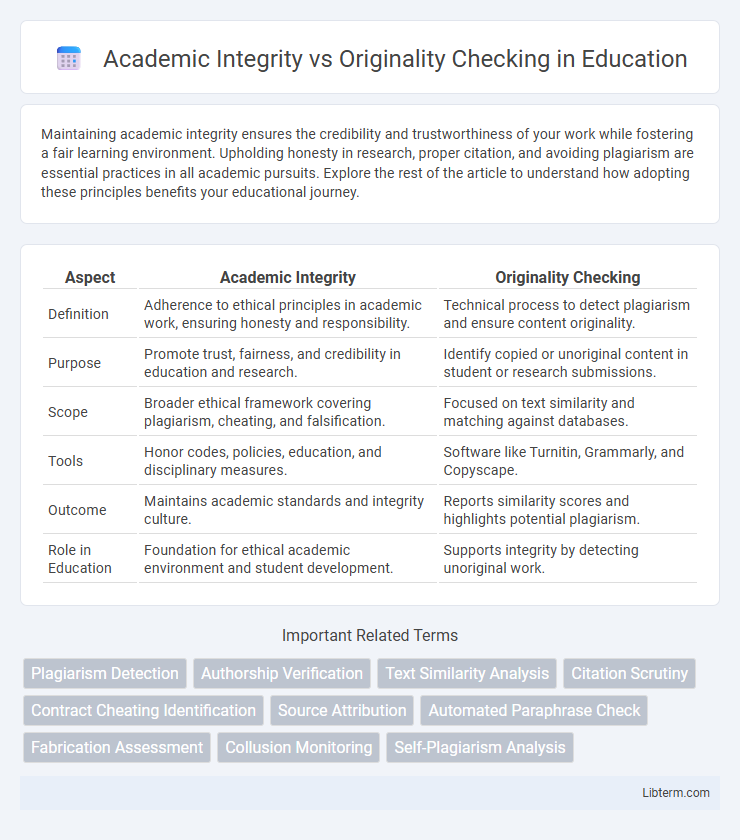Maintaining academic integrity ensures the credibility and trustworthiness of your work while fostering a fair learning environment. Upholding honesty in research, proper citation, and avoiding plagiarism are essential practices in all academic pursuits. Explore the rest of the article to understand how adopting these principles benefits your educational journey.
Table of Comparison
| Aspect | Academic Integrity | Originality Checking |
|---|---|---|
| Definition | Adherence to ethical principles in academic work, ensuring honesty and responsibility. | Technical process to detect plagiarism and ensure content originality. |
| Purpose | Promote trust, fairness, and credibility in education and research. | Identify copied or unoriginal content in student or research submissions. |
| Scope | Broader ethical framework covering plagiarism, cheating, and falsification. | Focused on text similarity and matching against databases. |
| Tools | Honor codes, policies, education, and disciplinary measures. | Software like Turnitin, Grammarly, and Copyscape. |
| Outcome | Maintains academic standards and integrity culture. | Reports similarity scores and highlights potential plagiarism. |
| Role in Education | Foundation for ethical academic environment and student development. | Supports integrity by detecting unoriginal work. |
Understanding Academic Integrity: Core Principles
Academic integrity embodies principles such as honesty, trust, fairness, respect, and responsibility within the academic community. It requires students and researchers to produce genuine work, properly credit sources, and avoid cheating or plagiarism. Originality checking tools support academic integrity by identifying unintentional overlaps but do not replace the ethical obligation to maintain authenticity and uphold scholarly standards.
Defining Originality Checking in Academia
Originality checking in academia refers to the process of evaluating a scholarly work to ensure that the content is unique and free from plagiarism by comparing it against a vast database of existing publications, student papers, and online sources. It involves using specialized software tools such as Turnitin or iThenticate, designed to detect text similarities and properly attribute sources. This practice supports academic integrity by preventing intellectual property theft and promoting honest scholarship.
Key Differences Between Academic Integrity and Originality Checking
Academic integrity emphasizes ethical principles such as honesty, trust, and responsibility in academic work, ensuring all contributions are properly credited and research is conducted truthfully. Originality checking involves using software tools to identify potential plagiarism by comparing submitted texts against databases, focusing specifically on the uniqueness of the content. The key difference lies in academic integrity encompassing a broader ethical framework, while originality checking serves as a technical process to support and enforce those ethical standards.
The Role of Technology in Upholding Academic Standards
Technology enhances academic integrity by providing sophisticated originality checking tools that detect plagiarism and ensure authentic work. Advanced algorithms analyze vast databases of academic content, enabling educators to identify unoriginal submissions efficiently. These innovations uphold academic standards by fostering a culture of honesty and accountability in educational institutions.
Common Misconceptions About Plagiarism Detection Tools
Plagiarism detection tools serve primarily as aids to identify potential text overlaps but do not determine academic integrity violations or originality judgments on their own. Common misconceptions include believing these tools can replace human evaluation or that a low similarity score guarantees originality, while context and proper citation practices remain crucial. Users should understand these tools highlight matches for further review rather than conclusively proving plagiarism or authentic content creation.
Human Judgment vs Automated Originality Checking
Academic integrity relies heavily on human judgment to interpret context, intent, and nuances in student work, which automated originality checking tools alone cannot fully grasp. While plagiarism detection software efficiently identifies text similarities and potential unoriginal content through algorithmic analysis, it may yield false positives or overlook subtle cases requiring ethical assessment. Combining human expertise with automated technology ensures a balanced approach that upholds academic standards while accurately evaluating originality.
The Impact of Academic Integrity Policies on Student Behavior
Academic integrity policies significantly influence student behavior by fostering an environment of trust and accountability, which reduces instances of plagiarism and promotes genuine learning. Implementing strict originality checks using advanced plagiarism detection tools reinforces ethical standards and deters academic dishonesty. These policies encourage students to develop critical thinking and authentic research skills, ultimately enhancing the quality of academic output.
Challenges in Balancing Originality with Creative Freedom
Balancing academic integrity with originality checking presents challenges such as maintaining rigorous standards without stifling creative freedom or discouraging innovative ideas. Overreliance on plagiarism detection tools can lead to false positives, creating anxiety and limiting authentic expression among students and researchers. Ensuring ethical scholarship requires nuanced policies that respect originality while upholding trust and fairness in academic work.
Best Practices for Promoting Academic Honesty
Promoting academic honesty requires clear communication of plagiarism policies and regularly educating students on the ethical use of sources and proper citation techniques. Integrating originality checking tools alongside manual evaluations helps detect unintentional plagiarism while fostering a deeper understanding of academic integrity principles. Encouraging open discussions about intellectual property and creating assignments that emphasize critical thinking over rote reproduction further supports a culture of honesty and originality.
Future Trends in Academic Integrity and Originality Verification
Future trends in academic integrity and originality verification emphasize AI-driven plagiarism detection tools that utilize machine learning algorithms to identify subtle text manipulations and paraphrasing. Enhanced blockchain technology adoption ensures tamper-proof academic records, fostering transparent and verifiable research provenance. Integration of comprehensive metadata analysis alongside behavioral analytics provides deeper insights into authorship authenticity and potential integrity breaches.
Academic Integrity Infographic

 libterm.com
libterm.com